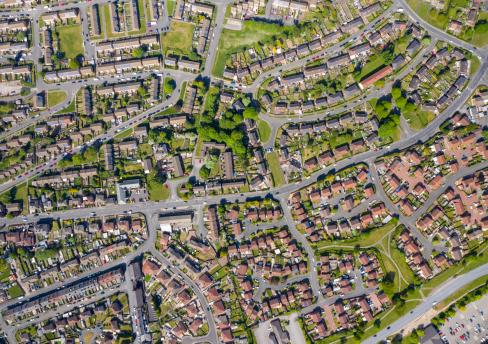Before I get to the issue of voluntary registration, I'll give you a brief summary of how land registration was set up in Scotland, and the differences between it and the (still operating) Register of Sasines, which will eventually be phased out completely.
Back in 1979, while Gloria Gaynor was Top of the Pops, in Scotland the Land Register was established by the Land Registration (Scotland) Act. By 1981, the Land Register was up and running and land registration began to replace the recording of deeds in the Sasine Register.
Sasine Register
The Sasine Register is one of the world's oldest public property registers - established in 1617 - and is a register of deeds. A copy of a deed submitted is retained by the Registers of Scotland; the original deed is returned to the submitting agent. This results in a register which comprises copy deeds in chronological order.
If someone is trying to find out who owns a property, they can search this register. However, it can sometimes be difficult to find the answer if the property does not have a postal address that appears on a recent deed on the register and the person searching does not know the details of any previous deeds which transferred ownership of the property.
Land Register
In contrast, the Land Register is not a register of deeds but is an OS map based public register of interests in land - which allows questions as to land ownership to be answered based on a map based search. Since 2002 this can be accessed on-line through Registers Direct for a relatively small fee - making the information easily accessible to the public.
Land registration results in production of a Land Certificate or Title Sheet which incorporates a red lined plan showing the extent of the property owned - all backed up by a state indemnity. The state indemnity has been changed in various ways by the Land Registration etc (Scotland) Act 2012 ("2012 Act"), but that is a whole different topic. One aspect of it, the changes to the Keeper's "Midas Touch" was referred to in Caroline Docherty's article last year.
Land registration was introduced gradually as different counties became operational and it was another 12 years until the Land Register became fully operational in all counties across Scotland. Some of my more senior colleagues can recall the 1979 Act coming into effect - and perhaps some of them were singing Gloria Gaynor's "I Will Survive" as they grappled with this new system with all the changes that the Act entailed. It took long enough for all parts of Scotland to become operational that I can still recall as trainee having a colourful map of Scotland on my office wall - showing the dates that counties were to go live through until 2003 when the last six counties were due to become operational areas. These days my colourful Operational Areas map - and indeed cellular offices with walls adorned with maps - are a dim and distant memory.
Speeding up completion of the Land Register
The main route to land registration was when a property is transferred for value. Many changes have been made by the 2012 Act to widen the triggers for compulsory land registration (including any transfer of title, regardless of whether it is for value or not), but even today we still record some deeds in the Sasine Register, for example on the grant of a fixed security over a non land-registered property.
Although we have been using the Land Register for over 20 years, by 2014 the Land Register was reported to comprise 1.5 million titles, representing only 58% of all potential property titles in Scotland and 26% of Scotland's land mass.
Voluntary registration of all publicly owned land within 5 years
In the interests of transparency and allowing the public easily to ascertain who owns what, it is generally seen as a good idea for all properties to be on the Land Register. As such, in May 2014, the Scottish Government confirmed that they had asked the Registers of Scotland to complete Land Registration in Scotland within 10 years, with all public land being registered within 5 years.
To achieve this stated aim, given the fact that not all unregistered land will change hands over that relatively short period, a central part to this will be voluntary land registration. There is also the possibility of Keeper induced registration where the Keeper decides to requisition property for land registration. The Keeper has confirmed that whilst previously consent was required before voluntary registration applications could even be submitted, from 20 October 2014 an application can be submitted without prior consent - although that doesn’t guarantee that the Keeper will ultimately accept the application.
With a commitment to register publicly owned land within 5 years, many public sector organisations face a fairly imminent deadline. Where they have large land holdings the scale of the task to land register all of their property is significant. So what might the task of voluntary registration involve?
What is involved in voluntary registration?
In many cases the scale of the task is hard to assess without some initial scoping of the titles. In an ideal case, a non land registered title might comprise one deed in favour of the current owner, with a clear red lined OS based plan attached to it, narrating that some title conditions apply. All quite straightforward.
However, in many other cases there might be a whole jigsaw of different parcels of land that make up the title, acquired on different dates, with other deeds referred to for title conditions (some of which conditions may or may not apply following feudal reform). For good measure, the extent of the property might be based on a written description with boundary measurements or even reference to who owned the adjoining property two hundred years previously!
Because the land registration process involves plotting the extent of the property on the OS map, a prerequisite to this is that there is an adequate description or a plan to enable this to be done. A Plans Report can be ordered as part of the initial scoping exercise to ascertain:
- whether or not the property can be identified
- whether the boundaries correspond with the physical features as defined on the current OS map
- whether the title to the property is affected by any other registered title and
- to show any competition with existing registered titles.
It may be that, as a result of obtaining a Plans Report, remedial conveyancing and/or a new plan may be required.
In some cases, the owner might need to prepare an affidavit confirming the extent of their occupation to evidence that an area which might appear to be outwith the Sasine description has in fact been owned and occupied by them over a significant period. This affidavit might enable the Keeper to proceed to include that area within the land registered title.
The initial scoping exercise would also involve ordering a Legal Report to check who is currently registered as title holder in the Sasine Register - there may have been unregistered changes through statutory provisions or corporate name changes. The Legal Report will also identify whether there have been any sales from the original extent or other deeds registered which might affect the property, such as grants of servitudes.
2012 Act changes to applications to the Land Register
The 2012 Act made some radical changes affecting to the rules relative to applications for land registration.
Applications, including those for voluntary land registration, submitted under this new regime require the solicitor submitting the application to have examined the underlying title and to confirm to the Registers of Scotland that there are adequate access rights, no issues with the title in favour of the applicant or with any links in title. Under the 1979 Act there was no need for the title to be reviewed to consider these issues prior to voluntary registration unless the client instructed its solicitor to do so.
As well as the cost of reviewing and submitting the titles, land registration dues on voluntary registration are based on the valuation of the property on the basis of a scale of fees.
An initial review of the title to scope the work involved in a particular application for voluntary registration enables any potential issues to be identified. It would also allow us to give you a clear price for the work to be undertaken on your behalf. If you are committed to, or otherwise considering, voluntary registration, we would be happy to hear from you.
If you'd like to speak to us, please contact our Real Estate team.
The content of this webpage is for information only and is not intended to be construed as legal advice and should not be treated as a substitute for specific advice. Morton Fraser LLP accepts no responsibility for the content of any third party website to which this webpage refers. Morton Fraser LLP is authorised and regulated by the Financial Conduct Authority.










